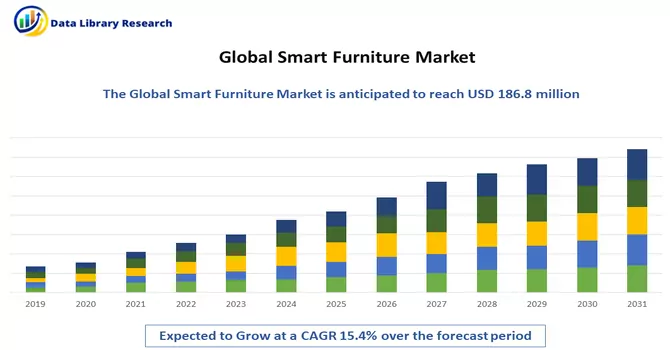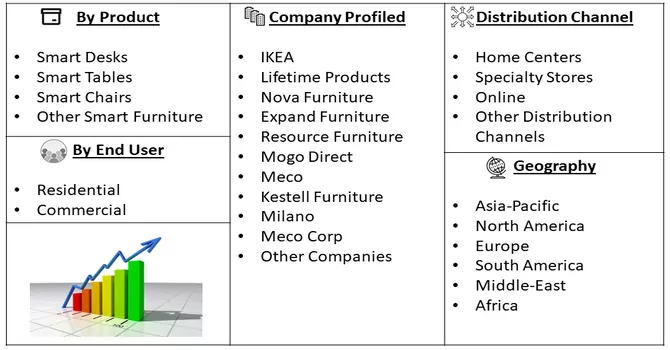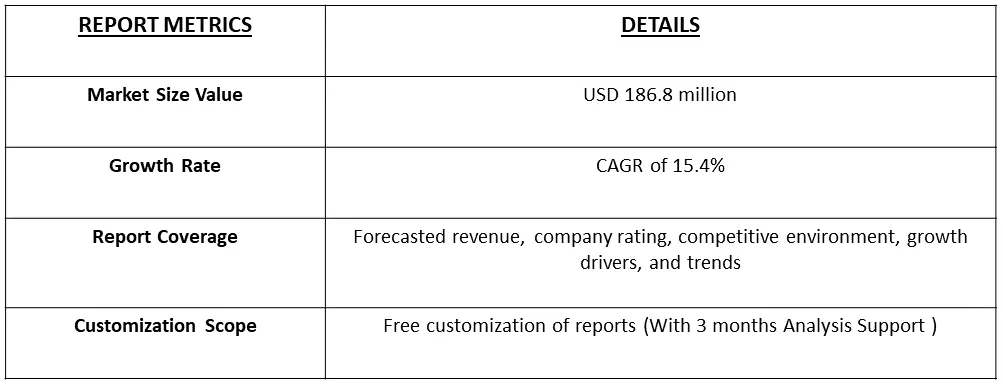The global smart furniture market size was valued at USD 186.8 million in 2023 and is expected to expand at a compound annual growth rate (CAGR) of 15.4% from 2024 to 2031.

Get Complete Analysis Of The Report - Download Free Sample PDF
Smart furniture refers to pieces of furniture that integrate advanced technology and connectivity features to enhance their functionality and provide additional value to users. These furniture items are equipped with embedded sensors, actuators, and electronic components, allowing them to interact with users, respond to environmental conditions, and perform various tasks. Smart furniture often incorporates elements of the Internet of Things (IoT) to enable communication and control through mobile devices or other connected platforms. Common features of smart furniture include built-in USB ports, wireless charging pads, LED lighting systems, climate control capabilities, and integrated speakers or entertainment systems. These technological enhancements are designed to improve convenience, efficiency, and user experience, making smart furniture particularly relevant in modern homes and offices where automation and connectivity play a significant role in daily life.
Key drivers propelling the industry forward include the increasing adoption of technology-driven workspaces in corporate offices, particularly those serving the IT, research, and laboratory sectors. This trend is complemented by a growing demand for efficient and purposeful work furniture, particularly among professionals engaged in remote work setups. The surge in work-from-home arrangements has emphasized the need for furniture that not only accommodates technological advancements but also optimizes functionality to enhance productivity and comfort. As technology continues to play a crucial role in modern work environments, the demand for smart and adaptable furniture solutions is on the rise, driven by the evolving preferences of both corporate and home-based professionals.
Market Segmentation: The Report Covers Smart Furniture Technology and it is Segmented By Product (Smart Desks, Smart Tables, Smart Chairs, Other Smart Furniture), End User (Residential, Commercial), Distribution Channel (Home Centers, Specialty Stores, Online, Other Distribution Channels), Geography (North America, Europe, Asia-Pacific, Latin America, Middle-East and Africa).

For Detailed Market Segmentation - Download Free Sample PDF
The smart furniture market is currently characterized by several prominent trends. There is a growing demand for multifunctional smart furniture that integrates technological features with adaptability, addressing the needs of individuals in compact living spaces. The rise of smart homes and the Internet of Things has led to increased connectivity features in furniture, allowing users to control and monitor various aspects through mobile devices or voice commands. Health and wellness considerations are driving the integration of ergonomic designs, biometric sensors, and adjustable settings in smart furniture to enhance overall well-being. Sustainability is a key focus, with a shift towards eco-friendly materials and energy-efficient technologies. In the corporate sector, the adoption of smart office furniture is on the rise, emphasizing the use of technology to improve productivity, collaboration, and employee satisfaction. These trends collectively underscore the industry's commitment to innovation, connectivity, and sustainability to meet the evolving preferences of consumers.
Market Drivers:
Rise in Adoption of IoT
The smart furniture market is driven by several key factors contributing to its growth and adoption. Firstly, the increasing trend of smart homes and the rise of the Internet of Things (IoT) have significantly propelled the demand for furniture embedded with connectivity features. Consumers seek furniture that can seamlessly integrate into their connected living spaces, allowing for remote control and monitoring through smartphones or voice commands. The multifunctionality of smart furniture, combining technological innovation with versatile designs, caters to the needs of individuals in modern, compact living environments. Additionally, the growing focus on health and wellness has led to the incorporation of smart features, such as ergonomic designs, biometric sensors, and adjustable settings, promoting comfort and overall well-being. Sustainability is emerging as a crucial driver, with a rising demand for eco-friendly materials and energy-efficient technologies in smart furniture. Lastly, the increasing adoption of technology in corporate offices and workspaces is fueling the demand for smart office furniture, designed to enhance productivity, collaboration, and employee satisfaction. These market drivers collectively reflect the dynamic intersection of technology, functionality, and consumer preferences in the evolution of the smart furniture market.
Rise in the Adoption of Tech-Savy Workspaces Across Corporate Offices Serving IT, Research, and Laboratories
The surge in the adoption of tech-savvy workspaces within corporate offices, particularly those catering to IT, research, and laboratory environments, is driving a notable trend in the integration of smart furniture. As these sectors emphasize innovation and efficiency, there is a growing demand for furniture solutions that complement the cutting-edge technologies prevalent in these workspaces. Smart furniture, with its embedded technology and connectivity features, aligns seamlessly with the needs of these high-tech industries. For instance, smart desks equipped with wireless charging capabilities, IoT-enabled ergonomic chairs, and collaborative workstations with integrated connectivity are becoming essential components in fostering productivity and innovation in these dynamic work environments. The use of smart furniture not only enhances the overall functionality and comfort within these tech-driven offices but also contributes to creating a futuristic and adaptable workspace that aligns with the evolving demands of modern professionals in IT, research, and laboratory sectors.
Restraints:
Higher Cost Associated With Integrating Advanced Technologies Into Furniture
The smart furniture market faces several restraints that impede its widespread adoption. One significant challenge is the higher cost associated with integrating advanced technologies into furniture, making these products less accessible to budget-conscious consumers. Interoperability issues and compatibility concerns between different manufacturers' products hinder seamless integration within connected home or office ecosystems. Privacy and security concerns arise due to the collection and transmission of user data by smart furniture, leading to apprehensions about potential breaches. Additionally, the rapid pace of technological advancements raises fears of obsolescence, necessitating continuous updates to ensure relevance. Addressing these challenges, including cost barriers, interoperability issues, privacy concerns, and the need for ongoing technological updates, is essential for the smart furniture market to overcome restraints and achieve broader consumer acceptance.
The COVID-19 pandemic has had a multifaceted impact on the smart furniture market. On one hand, the increased prevalence of remote work and the transformation of home spaces into multifunctional environments has accelerated the adoption of smart furniture. Consumers, now spending more time at home, are seeking furniture solutions that enhance their living spaces with features like ergonomic designs, connectivity options, and health monitoring capabilities. The demand for smart home office furniture, in particular, has surged as individuals invest in comfortable and technologically advanced setups. On the other hand, the economic uncertainties resulting from the pandemic have led some consumers to prioritize essential purchases over non-essential items like smart furniture, affecting market growth. Disruptions in supply chains and manufacturing delays have also impacted the availability of certain products. As the situation evolves, the smart furniture market is poised for recovery with ongoing trends in remote work and smart home integration likely to shape consumer preferences in a post-pandemic era. The industry is adapting to these challenges by focusing on innovation, cost-effective solutions, and addressing changing consumer needs in the evolving landscape of the "new normal."
Segmental Analysis:
Smart Chair Segments is Expected to Witness Significant Growth Over the Forecast Period
Smart chairs, equipped with advanced technologies, serve various functions to enhance comfort, productivity, and overall well-being. One common application is in the realm of office furniture, where smart chairs are designed with ergonomic features, adjustable settings, and sensors to promote a healthier and more comfortable work environment. These chairs may include built-in lumbar support, adjustable height, and even posture monitoring to encourage better sitting habits and reduce the risk of musculoskeletal issues. In the smart home context, chairs with integrated connectivity can be part of a larger ecosystem, allowing users to control and customize settings through mobile apps or voice commands. Some smart chairs also incorporate massage or heating functionalities for relaxation and stress relief. Additionally, in healthcare settings, smart chairs equipped with monitoring capabilities can be used to track vital signs and enhance patient comfort. The versatility of smart chairs spans across various sectors, providing a blend of innovative features tailored to meet the specific needs of users in different environments.
Commercial Segments is Expected to Witness Significant Growth Over the Forecast Period
The commercial use of smart furniture has become increasingly prevalent across various industries, offering innovative solutions to enhance efficiency, productivity, and user experience. In corporate settings, smart office furniture is being deployed to create connected workspaces. Smart desks with adjustable heights, built-in charging stations, and IoT capabilities enable employees to customize their workstations for comfort and productivity. Meeting rooms equipped with smart furniture facilitate seamless collaboration through integrated technology, including interactive displays and connectivity features. Retail spaces are adopting smart furniture for interactive customer experiences. Smart shelves, digital kiosks, and augmented reality-enabled fitting rooms enhance the overall shopping experience. In hospitality, smart furniture is integrated into hotel rooms to provide guests with personalized controls for lighting, climate, and entertainment. Additionally, healthcare facilities are utilizing smart furniture with monitoring capabilities to enhance patient comfort and streamline healthcare delivery. The commercial use of smart furniture is driven by the desire to create technologically advanced, efficient, and user-friendly environments tailored to the specific needs of each industry.
Speciality Stores Segments is Expected to Witness Significant Growth Over the Forecast Period
Specialty stores play a crucial role in the market for smart furniture, offering a curated and immersive shopping experience for consumers seeking cutting-edge, technology-infused home and office furnishings. These stores, often dedicated to furniture and home innovation, provide a distinct advantage by showcasing a carefully selected range of smart furniture options. Customers visiting specialty stores can benefit from the expertise of staff who are well-versed in the unique features and functionalities of smart furniture. The hands-on environment allows consumers to interact with the products, test technological features, and gain a deeper understanding of how these pieces can enhance their living or working spaces. Specialty stores are instrumental in bridging the gap between technological innovation and consumer awareness, offering a space where individuals can explore the latest advancements in smart furniture, understand their applications, and make informed purchase decisions. As the demand for smart furniture grows, specialty stores are well-positioned to cater to consumers who prioritize technology, innovation, and the seamless integration of smart solutions into their living environments.
Asia Pacific Region is Expected to Witness Significant Growth Over the Forecast Period
The Asia-Pacific region is witnessing a significant surge in the adoption of smart furniture, reflecting a growing trend towards technological integration in modern living and working spaces. Countries such as China, Japan, India, and South Korea are at the forefront of this movement, driven by rapid urbanization, increasing disposable income, and a tech-savvy population. In urban centers where space optimization is crucial, smart furniture offers innovative solutions for both residential and commercial applications. In the residential sector, consumers are embracing smart furniture for home automation, incorporating features like smart lighting, climate control, and integrated entertainment systems. The rise of compact living spaces in urban areas has also boosted the demand for multifunctional smart furniture that maximizes functionality in constrained environments. In the commercial sector, particularly in corporate offices, the Asia-Pacific region is adopting smart office furniture to create modern workspaces that enhance employee productivity and well-being. As the region continues to embrace smart technology and connectivity, the use of smart furniture is poised to become more widespread, shaping the future of living and working environments in this dynamic and tech-forward part of the world.

Get Complete Analysis Of The Report - Download Free Sample PDF
Major market players actively pursue strategies such as expanding their production capabilities, engaging in mergers and acquisitions, and conducting research and development initiatives to maintain a competitive edge in the industry. This involves increasing their capacity for manufacturing, acquiring other companies or merging with them to strengthen their market position, and investing in innovative research and development efforts. These strategic moves are crucial for staying ahead of competitors, enhancing market share, and ensuring sustained growth in the dynamic business environment. The commitment to these initiatives underscores the players' proactive approach in adapting to market trends, meeting evolving customer demands, and securing a prominent position in the competitive landscape. Some of the key market players working in this market are:
Recent Development:
1) In May 2022, Steelcase Inc. declared a definitive agreement to acquire HALCON, a precision-tailored wood office furniture designer and manufacturer based in Minnesota. This strategic move aims to enhance Steelcase's existing wood product collection, offering architects and designers unparalleled design options and master craftsmanship. The acquisition involved the purchase of all outstanding equity interests in HALCON for $127.5 million, with potential additional consideration of up to USD 9.5 million over three years contingent upon meeting specific performance criteria and Mr. Conway remaining employed.
2) In July 2021, Herman Miller successfully finalized its acquisition of Knoll, marking a transformative moment that positioned the company as a leading innovator in modern design. This union resulted in a conglomerate with 19 major brands, a global dealer network, 64 showrooms worldwide, over 50 physical retail locations, and extensive global e-commerce capabilities. The completion of this acquisition sets the stage for realizing the myriad advantages of this merger, allowing the combined entity to promptly leverage its enhanced capabilities and offerings in the market.
Q1. What was the Smart Furniture Market size in 2023?
As per Data Library Research the global smart furniture market size was valued at USD 186.8 million in 2023.
Q2. At what CAGR is the Smart Furniture market projected to grow within the forecast period?
Smart Furniture Market is expected to expand at a compound annual growth rate (CAGR) of 15.4% over the forecast period.
Q3. What are the factors driving the Smart Furniture Market?
Key factors that are driving the growth include the Rise in Adoption of IoT and Rise in the Adoption of Tech-Savy Workspaces Across Corporate Offices Serving IT, Research, and Laboratories.
Q4. Who are the key players in Smart Furniture Market?
Some key players operating in the market include
Data Library Research are conducted by industry experts who offer insight on industry structure, market segmentations technology assessment and competitive landscape (CL), and penetration, as well as on emerging trends. Their analysis is based on primary interviews (~ 80%) and secondary research (~ 20%) as well as years of professional expertise in their respective industries. Adding to this, by analysing historical trends and current market positions, our analysts predict where the market will be headed for the next five years. Furthermore, the varying trends of segment & categories geographically presented are also studied and the estimated based on the primary & secondary research.
In this particular report from the supply side Data Library Research has conducted primary surveys (interviews) with the key level executives (VP, CEO’s, Marketing Director, Business Development Manager and SOFT) of the companies that active & prominent as well as the midsized organization
FIGURE 1: DLR RESEARH PROCESS

Extensive primary research was conducted to gain a deeper insight of the market and industry performance. The analysis is based on both primary and secondary research as well as years of professional expertise in the respective industries.
In addition to analysing current and historical trends, our analysts predict where the market is headed over the next five years.
It varies by segment for these categories geographically presented in the list of market tables. Speaking about this particular report we have conducted primary surveys (interviews) with the key level executives (VP, CEO’s, Marketing Director, Business Development Manager and many more) of the major players active in the market.
Secondary ResearchSecondary research was mainly used to collect and identify information useful for the extensive, technical, market-oriented, and Friend’s study of the Global Extra Neutral Alcohol. It was also used to obtain key information about major players, market classification and segmentation according to the industry trends, geographical markets, and developments related to the market and technology perspectives. For this study, analysts have gathered information from various credible sources, such as annual reports, sec filings, journals, white papers, SOFT presentations, and company web sites.
Market Size EstimationBoth, top-down and bottom-up approaches were used to estimate and validate the size of the Global market and to estimate the size of various other dependent submarkets in the overall Extra Neutral Alcohol. The key players in the market were identified through secondary research and their market contributions in the respective geographies were determined through primary and secondary research.
Forecast Model
